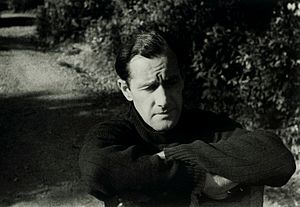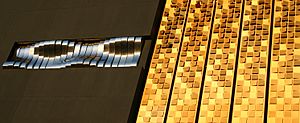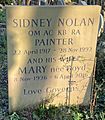Sidney Nolan facts for kids
Sir Sidney Robert Nolan (1917—1992) was one of Australia's most important artists. He used many art forms, including painting, drawing, and printmaking. He also designed sets for theatre, created murals, and used spray painting and collage. Nolan made over 10,000 artworks in his lifetime.
He is very famous for his series of 27 paintings about the Ned Kelly story. His friend, Sunday Reed, gave 25 of these paintings to the National Gallery of Australia in Canberra. A special room was built there to show them. In 2010, one of the Kelly paintings was given to the National Gallery of Victoria. Another Kelly painting, not owned by a museum, was sold in 2010 for AU$5.4 million. This was the highest price ever paid for an Australian painting at that time.
Nolan was born in Carlton, Victoria on April 22, 1917. He studied art at Prahran Technical College and the National Gallery School in Melbourne. In 1948, he moved to Sydney. Then, in 1953, he moved to London, where he lived until he passed away on November 28, 1992.
Contents
Exploring Art: Sidney Nolan's Career
Sidney Nolan painted many historical and legendary figures. These included explorers like Burke and Wills and Eliza Fraser. He showed his own unique view of these people.
His most famous works are probably the paintings of the bushranger Ned Kelly. These paintings show the main parts of the Kelly story. However, Nolan did not mean for them to be exact pictures of what happened. The Kelly story also helped Nolan paint the Australian landscape in new ways. The story gave special meaning to the places he painted.
Nolan never stuck to just one style or method. He always tried new ways of painting throughout his life. He even invented some of his own techniques. He was inspired by children's art and modern paintings from the early 1900s.
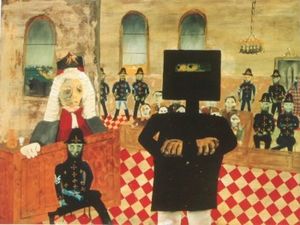
Nolan's Ned Kelly series is one of the most important Australian painting collections of the 20th century. His simple way of showing Kelly in his armour has become a famous Australian image. In 1949, when the series was shown in Paris, the museum director called them "a striking contribution to modern art." He said Nolan created "a wonder of something new being born."
Later Kelly paintings were bought by big international galleries. These included the Museum of Modern Art in New York and the Tate Modern in London.
Nolan also painted landscapes of Dimboola, Victoria. He was stationed there during World War II while serving in the army. These paintings can be seen at the National Gallery of Victoria.
In 1951, Nolan moved to London, England. He traveled around Europe. In 1956, he spent a year in Greece, painting pictures based on Greek mythology.
In 1965, Nolan finished a very large mural. It was 20 meters long and 3.6 meters high. This mural showed the 1854 Eureka Stockade event. He made it using enamel jewellery on heavy copper. Nolan used a special "finger-and-thumb" drawing method. This was like the technique used by Indigenous Australian sandpainters. The mural is located in Melbourne at the entrance to the Reserve Bank of Australia.
Between 1968 and 1970, Nolan worked on another huge mural called Paradise Garden. This project had 1,320 flower designs. He made them with crayon and dyes. The mural showed the life cycles of plants. It started with plants growing from mud, then bursting with color in spring, and finally returning to the earth.
In England, Nolan went to the Aldeburgh Festival. He was influenced by the composer Benjamin Britten, who organized the festival. Nolan showed his paintings at these festivals. He kept traveling widely to Europe, Africa, China, Australia, and even Antarctica.
Sidney Nolan's Final Years
Nolan passed away in London on November 28, 1992, at 75 years old. He was survived by his wife and two children. He was buried in the eastern part of Highgate Cemetery in London.
Other Creative Works
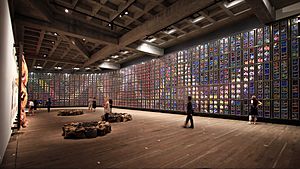
Designing for the Stage
Nolan started working with theatre in 1939. He was asked to design the sets for a ballet called Icare. The ballet dancer Serge Lifar saw Nolan's abstract art and offered him the job. Icare was first performed in Sydney in 1940.
In 1964, Robert Helpmann asked Nolan to design the sets and costumes for his ballet The Display. This ballet was set at a bush picnic. It showed how lyrebirds behave when looking for a mate, comparing it to Australian men. Nolan created special green-blue panels to make the stage look like a forest with filtered light.
Awards and Recognition
Sidney Nolan received many honors for his art. In 1963, he was made a CBE (Commander of the Order of the British Empire). In 1981, he became a Knight Bachelor for his service to art. This meant he was called "Sir Sidney Nolan." He also received the Order of Merit (OM) in 1983, which is a very special award.
In 1983, Nolan settled in Herefordshire, England. The Sidney Nolan Trust was created in 1985. This trust helps artists and musicians. It also provides a place to show artworks by Nolan and others.
He was also made a Companion of the Order of Australia (AC) in 1988. He had previously declined a lower rank in the Order in 1975. He was also chosen as an honorary member of the American Academy of Arts and Letters and a member of the Royal Academy of Arts.
Nolan's Lasting Impact
At the 2000 Summer Olympics opening ceremony in Sydney, performers wore costumes based on Nolan's famous Ned Kelly images. A painting from Nolan's original Ned Kelly series was also shown on a huge screen in the stadium.
In 2010, Nolan's painting First-class Marksman (1946) became the most expensive Australian painting ever sold. This painting was the only one from Nolan's first Ned Kelly series that was not owned by the National Gallery of Australia. The Art Gallery of New South Wales bought it for $5.4 million.
The 1971 Australian film Walkabout was greatly influenced by Nolan's art. For example, a scene where a boy sees camel riders in the desert was directly inspired by Nolan's Burke and Wills paintings.
Two of Nolan's paintings, The Abandoned Mine (1948) and Ned Kelly (1955), were included in the 2007 book 1001 Paintings You Must See Before You Die.
Nolan's life and art have inspired many books and films. The 2011 novel Spirit of Progress by Steven Carroll was inspired by Nolan's painting Woman and Tent. The young artist in the novel is based on Nolan. Another novel, Autumn Laing by Alex Miller, explores Nolan's relationship with Sunday Reed.
Several documentary films have been made about Nolan. Kelly Country (1972) explored Australia's landscape and stories through Nolan's art. A 2009 documentary, Mask and Memory, looked at Nolan's personal life. It showed how the main women in his life, Sunday Reed, Cynthia Nolan, and Mary Nolan, greatly influenced his art.
In 2013, Nolan's art collection was one of the largest in Australia.
Images for kids
See also
 In Spanish: Sidney Nolan para niños
In Spanish: Sidney Nolan para niños


